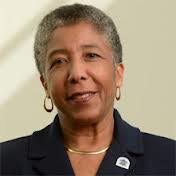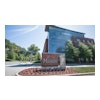 Dr. Mary Foster Gnage, Chair of the AACC Board of Directors, said the theme of this year’s conference is “Reimagining the Community College.”
Dr. Mary Foster Gnage, Chair of the AACC Board of Directors, said the theme of this year’s conference is “Reimagining the Community College.”SAN FRANCISCO — Hundreds of community college faculty, staff and administrators have participated in several days of collaborative and motivational sessions at the American Association of Community Colleges’ Annual Conference. Dr. Walter Bumphus, AACC president and CEO, proudly stated to a crowd of more than 300 people that this is a “Camelot moment for community colleges. These really are the best of times.” He was referring to the attention and support that community colleges are receiving from businesses and all levels of government.
But the Camelot analogy also speaks to the collaborative nature of the conference. In several sessions, the attendees huddled their chairs together in circles and shared their advice and experiences. Presenters opened themselves up to learn from the audience rather than limiting themselves to a lecture-style presentation.
Marie Foster Gnage, the Chair of the AACC Board of Directors, announced that the official theme of this year’s conference is “Reimagining the Community College.” Yet, in several sessions related to diversity issues, another theme emerged: breaking down stereotypes while still embracing our diverse communities.
Dr. Joan Holmes, Special Assistant to the President at Hillsborough (Fla.) Community College, emphasized that the face of diversity has changed in community colleges in a session about chief diversity officers. In addition to racial tensions, administrators have to also consider diversity in relation to religion, sexual orientation, gender and disabilities.
Holmes enlightened her audience with stories of how faculty members have unintentionally made comments about Muslims, women, or other minority groups that resulted in serious complaints from students. As the leader of diversity issues at her school, she works closely with faculty to ensure that students are not insulted and that stereotypes are not perpetuated.
In a similar vein, several community college presidents spoke of the damaging stereotypes of Asian-American students. Dr. Audrey Yamagata-Noji refuted the premise that Asians are the “model minority” and are taking over selective four-year universities. Her statistics showed that the majority of Asian-American students attend public colleges and that their needs are often overlooked in part because of the stereotype that Asians do well in school.
Rosie Rimanda-Chareunsap, vice president of Student Services at South Seattle Community College, spoke about the steps her school took to meet the needs of their growing population of Asian-American students in spite of stereotypes. The college applied and received designation as an Asian American Native American Pacific Islander Serving Institution (AANAPISI). With grant money from this federal designation, South Seattle was able to create “small, organic learning groups” for Asian-American students and has seen an improvement in student achievement as a result. These targeted, impactful strategies worked well alongside campus-wide diversity initiatives like an online resource center for Asian-American students.
Houston Community College found similar success by placing Black men in its Trio program into homogenous learning groups. In these groups, students see their differences are recognized and valued and can receive any unique assistance they may need. At HCC, a school-specific survey showed that students were dropping out of college despite the resources of the Trio program in part because of their feelings toward other Black men. Counselors like LaTonya Jones chose to combat this problem by promoting a sense of brotherhood and emphasizing male bonding through strategies like the learning cohorts.
Diversity doesn’t stop with the students. A group of Latino presidents of community colleges gave advice to others thinking of becoming presidents and emphasized that they do not have to let go of their heritage.
“Be proud of who you are,” Anna Solley, president of Phoenix College, fiercely tells her audience. She reveals that she is sometimes criticized for being “too Latina” in her role as president, but she remains proud of whom she is while providing equal attention and care to all her college’s communities.
The attendees of the AACC conference received a wealth of information but they were also issued a challenge: Go back to their schools armed with new knowledge and do things differently.


















